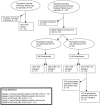Prevalence and significance of unrecognized lower extremity peripheral arterial disease in general medicine practice*
- PMID: 11422635
- PMCID: PMC1495229
- DOI: 10.1046/j.1525-1497.2001.016006384.x
Prevalence and significance of unrecognized lower extremity peripheral arterial disease in general medicine practice*
Abstract
Objective: To determine the prevalence of unrecognized lower extremity peripheral arterial disease (PAD) among men and women aged 55 years and older in a general internal medicine (GIM) practice and to identify characteristics and functional performance associated with unrecognized PAD.
Design: Cross-sectional.
Setting: Academic medical center.
Participants: We identified 143 patients with known PAD from the noninvasive vascular laboratory, and 239 men and women aged 55 and older with no prior PAD history from a GIM practice. Group 1 consisted of patients with PAD consecutively identified from the noninvasive vascular laboratory (n = 143). Group 2 included GIM practice patients found to have an ankle brachial index less than 0.90, consistent with PAD (n = 34). Group 3 consisted of GIM practice patients without PAD (n = 205).
Measurements and main results: Leg functioning was assessed with the 6-minute walk, 4-meter walking velocity, and Walking Impairment Questionnaire (WIQ). Of GIM practice patients, 14% had unrecognized PAD. Only 44% of patients in Group 2 had exertional leg symptoms. Distances achieved in the 6-minute walk were 1,130, 1,362, and 1,539 feet for Groups 1, 2, and 3, respectively, adjusting for age, gender, and race (P <.001). The degree of difficulty walking due to leg symptoms as reported on the WIQ was comparable between Groups 2 and 3 and significantly greater in Group 1 than Group 2. In multiple logistic regression analysis including Groups 2 and 3, current cigarette smoking was associated independently with unrecognized PAD (odds ratio [OR], 6.82; 95% confidence interval [95% CI], 1.55 to 29.93). Aspirin therapy was nearly independently associated with absence of PAD (OR, 0.37; 95% CI, 0.12 to 1.12).
Conclusion: Unrecognized PAD is common among men and women aged 55 years and older in GIM practice and is associated with impaired lower extremity functioning. Ankle brachial index screening may be necessary to diagnose unrecognized PAD in a GIM practice.
Figures
References
-
- McDermott MM, Mehta S, Greenland P. Exertional leg symptoms other than intermittent claudication are common in peripheral arterial disease. Arch Intern Med. 1999;159:387–92. - PubMed
-
- Criqui MH, Denenberg JO, Bird CE, Fronek A, Klauber MR, Langer RD. The correlation between symptoms and non-invasive test results in patients referred for peripheral arterial disease testing. Vasc Med. 1996;1:65–71. - PubMed
-
- Newman AB, Siscovick DS, Manolio TA, et al. Ankle-arm index as a marker of atherosclerosis in the Cardiovascular Health Study. Cardiovascular Heart Study (CHS) Collaborative Research Group. Circulation. 1993;88:837–845. - PubMed
-
- Criqui MH, Fronek A, Barrett-Conner E, Gabriel S. The sensitivity, specificity, and predictive value of traditional clinical evaluation of peripheral arterial disease: results from noninvasive testing in a defined population. Circulation. 1985;71:516–22. - PubMed
-
- Criqui MH, Langer RD, Fronek A, et al. Mortality over a period of 10 years in patients with peripheral arterial disease. N Engl J Med. 1992;326:381–6. - PubMed
Publication types
MeSH terms
Grants and funding
LinkOut - more resources
Full Text Sources

